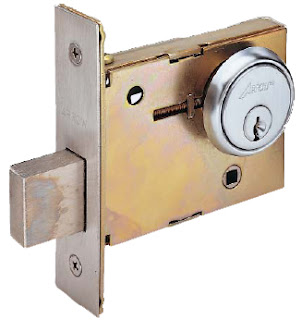A lock is a mechanical or electronic fastening device that
is released by a physical object (such as a key, keycard, fingerprint, RFID
card, or security token) or secret information (such as a keycode or password),
or combination of more than one of these.
Typically, in pin-tumbler and wafer-tumbler applications, a
lock in the rest position is closed. The key has a series of grooves on either
side of the key (the key's blade), which limit the type of lock the key can
slide into. As the key slides into the lock, the grooves on the blade of the
key align with the wards in the keyway allowing or denying entry to the
cylinder. Then, a series of pointed teeth and notches on the blade called
bittings allow pins or wafers to move up and down until they are in line with
the shear line of the inner and outer cylinder, allowing the cylinder or cam to
rotate freely inside the lock and the lock to open.
Types of locks
Locks may be entirely mechanical, or electromechanical. They
may be operated by turning some form of removable key, by keying or dialling in
a combination which directly or via electromechanical means operates the lock,
with some form of magnetic or other card reader, or by moving a part on a
safety lock intended to prevent accidental operation rather than to prevent
unauthorized access.
Warded lock
The warded lock is one of the earliest types of locks. It
said to have been developed in China.
Tumbler locks
Pin-tumbler lock
The Pin tumbler lock is the most widespread lock in the
western world. Pin-tumbler locks have been around in some form since 2000
BCE. The Egyptian form of this lock was large, heavy, and made of wood, with
pins made of metal, usually bronze, but sometimes iron. This design in its
modern form was first patented in 1805 in England. The patent holder was an
American named A.O. Stansbury. In the middle of the 18th century, the American
locksmiths Linus Yale Sr. and his son, Linus Yale Jr., refined the lock design
into the form recognizable today. These early versions of the pin-tumbler lock
were expensive to produce, and did not become widely available until mass
production became feasible.
Wafer-tumbler lock
The first patent for the wafer lock was issued in the United
States in 1868 to P.S. Felter. The wafer lock is relatively inexpensive to
produce and is often used in automobiles and cabinetry. This type of lock is
generally made of die-cast zinc alloy.
Lever locks
Lever locks were invented in Europe in the 17th century. This is a popular lock type for safes and North American prisons today, as they
are generally built of strong materials. They are also used as door locks in
some countries. This is the type of lock that replaced the medieval warded lock
in the 19th century. Robert Barron of England patented the double-acting lever
in 1778. Jeremiah Chubb would follow with his own detector lock in 1818.
Disc tumbler lock
The disc tumbler lock or Abloy lock was invented in 1907,
and is widespread in Finland. The mechanism contains no springs and is durable.
Picking the lock is too hard compared to alternative means of gaining entry.
Other types
There are also many other types of lock, such as warded
locks, tubular locks, electronic locks (itself a huge area) and also many
variations of the various types, such as dimple locks, which are a variation on
Yale's original cylinder lock in which the pins interact with the side of the
key rather than the edge, "laser track" car locks, which are a
variation on wafer locks, and some higher security lever locks also include the
types of warding found on warded locks.
List of common locks
 |
Bicycle lock |
 |
| Cam lock |
 |
| Child safety lock |
 |
| Combination lock |
 |
| Cylinder lock |
 |
| Deadbolt Lock |
 |
| Liver Lock |
 |
| Disc tumbler lock |
 |
| Warded lock |
 |
| Cruciform (or Zeiss) lock |
















0 comments:
Post a Comment